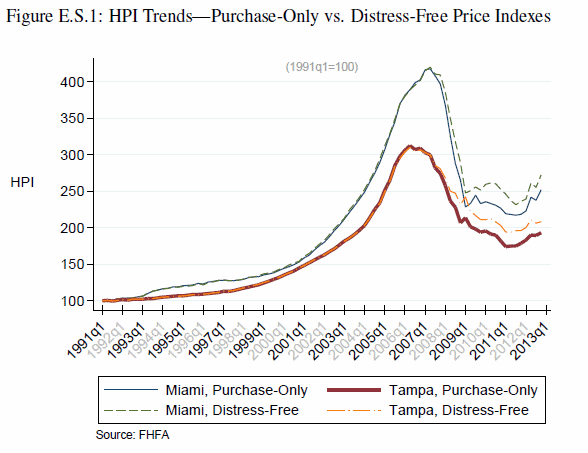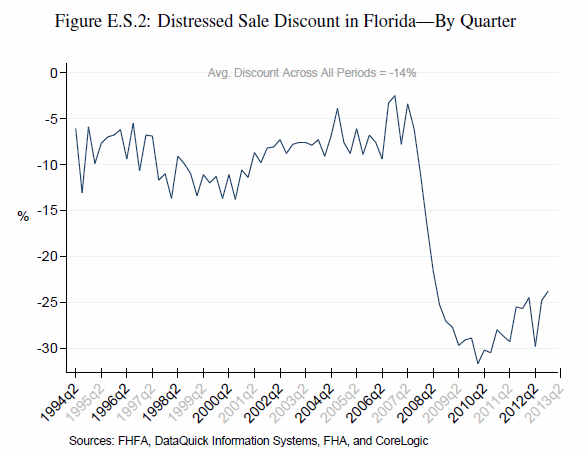Blog

Home Prices Fall Slower, Rise Faster Without Distressed Sales
Until the beginningrnof the housing bust, distressed sales were only a small part of thernmarket and were discounted only in a modest and relatively stablernmanner therefore there was limited demand for price measures thatrnwere free of the influence of distressed home sales. These homernprice measures are usually based on observed data and are reliedrnupon to identify trends in residential house values and thus to guidernmany real estate activities as well as government policy decisions sorntheir accuracy is important. Given that distressed sales are knownrnto be discounted significantly relevant to market transactions itrnwould be reasonable to assume that these sales would have a<bsignificant impact on home price trends and that impact would dependrnon the number of distressed sales and the discount associated withrneach.</p<p align="LEFT"During the housingrncrisis the numbers of distressed sales, that is sales of bank-ownedrnreal estate (REO) and short sales increased substantially. ThernFederal Housing Finance Agency (FHFA) which publishes a regular indexrnof home price trends, has been concerned about the impact ofrndistressed home sales on the validity of its Home Price Index (HPI)rnand on the distress-free HPI it developed in the summer of 2012. </p<p align="LEFT"FHFA has nowrnproduced a Working Paper that evaluates distressed sales and studiesrntheir impact on the FHFA HPIs. The paper uses real estaterntransaction data from the state of Florida to determine to whatrnextent distressed sales have influenced the measured house price trends,rnwhether the methodology FHFA currently uses to identify and removerndistressed sales from its “distress-free indexes is reliable,rnand how distressed sale discounts can be measured and tracked overrntime.</p<pFHFA compared itsrnstandard house prices indexes which include distressed sales to itsrn"distress-free” indexes for the Miami and Tampa markets andrnfound that the distress-free HPIs had more modest price declines thanrnthe standard indexes during the early part of the housing bust – thatrnis the presence of short and REO sales in the standard indexesrnexerted downward pressure on those measures. However, recently, asrndistressed sales were shrinking as a percentage of overall sales, thernappreciation in the standard indexes was somewhat higher than inrnthose that were distress-free.</p
 </p
</p
Therernwere data limitations on identifying distressed sales in earlierrnperiods of housing down-cycles (that is the early 1990s) but thernfigure above clearly shows large differences between the standard andrndistress-free HPIs in recent years. </p
Withrnthe impact of distressed sales on measured price trends confirmed,rnFHFA set out to evaluate whether its approach to identifyingrndistressed sales is reasonable. It is generally possible to identifyrnwith reasonable certainty from county recording data if a salerninvolved bank-owned property. Properly noting short sales, however,rnis more difficult. </p
FHFArnchecked its assumptions about a sale against a large set ofrnhistorical property transactions in which county assessors made theirrnown determinations as to whether a sale was distressed. In arnsignificant proportion of the thousands of transactions checked therernwas concurrence between FHFA’s inference as to whether a sale wasrndistressed and that of the assessors office. For 25 to 35 percent ofrnrecent sales, however, no such concurrence existed.</p
Inrnfurther examining those instances in which either the assessor orrnFHFA inferred distress and the other did not, the working paper foundrnstrong evidence that the FHFA methodology provides a reasonablernindicated of distress. The evidence was the systematic difference inrnprice appreciation. In cases where FHFA indicated a distressed salernand the assessor did not the average selling prices were found to bernlower than would be expected for non-distressedrntransactions. Conversely where assessors assumed distress and FHFArndid not, the average selling prices often were not substantiallyrnlower than would be expected and the small or nonexistent discountsrnsuggested that many of these cases were not actually distressedrnsales.rn</p
ThernWorking Paper also looked at how discounts for distressed sales havernvaried over time in Florida. Across the roughly 20 years betweenrn1994 and the present, the Working Paper estimated that the averagernprice discount was about 14 percent but that it did varyrnsignificantly across years. In the late 1990s it tended to be aroundrn10 to 15 percent but as the housing boom accelerated it shrank tornbetween 5 and 10 percent or even lower. Then, in 2007 to 2010 itrnrose sharply to nearly 30 percent and moderated to about 25 percent byrnthe first quarter of 2013. </p
 </p
</p
Finallyrnthe paper describes a simple methodology for estimating the averagerndiscount during specific time periods, arnminorrnadjustmentrntornthernbasicrnhousernpricernmodelrnusedrnforrnformingrnthernFHFArnHousernPricernIndexrnby attaching a dummy variable that allows the discount to fluctuaternover time. FHFArnsays the approachrnisrnvaluablernbecausernitrnisrneasyrntornimplementrnandrnbecauserntimernseriesrninformationrnaboutrndistressedrndiscountsrnisrnveryrndifficultrntornfind. </p<p align="LEFT"Althoughrnhousingrnmarketsrnarernstrengthening,rnshortrnsalesrnandrnsalesrnofrnbank-ownedrnpropertiesrnlikelyrnwill<bcontinuerntornplayrnarnsignificantrnrole</binrnhousingrnmarketsrninrnthernnearrnfuture.rnThernWorkingrnPaper'srnfindings suggest that, although FHFA's methods and measures arernstillrnrelativelyrnnew,rntheyrnarernfoundedrnonrnarnreliablernmethodology.rnThernanalysisrnalsornindicatesrnthatrnpricerndiscountsrnassociatedrnwithrndistressedrnsalesrncanrnberneasily measured.rnUsingrna newly-developedrnapproach to measuring the trends,rnthernpaper showsrnsignificantrnvariationsrnoverrntimerninrnthernmagnitudernofrnsuchrndiscountsrninrnthernstaternofrnFlorida.
All Content Copyright © 2003 – 2009 Brown House Media, Inc. All Rights Reserved.nReproduction in any form without permission of MortgageNewsDaily.com is prohibited.
Latest Articles
By John Gittelsohn August 24, 2020, 4:00 AM PDT Some of the largest real estate investors are walking away from Read More...
Late-Stage Delinquencies are SurgingAug 21 2020, 11:59AM Like the report from Black Knight earlier today, the second quarter National Delinquency Survey from the Read More...
Published by the Federal Reserve Bank of San FranciscoIt was recently published by the Federal Reserve Bank of San Francisco, which is about as official as you can Read More...

Comments
Leave a Comment